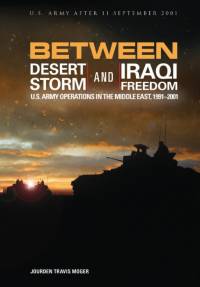Om Between Desert Storm and Iraqi Freedom
From 1991 to 2001, the U.S. Army deterred Iraqi aggression and maintained a high tempo of operations, despite a decade of downsizing and consolidation. Even as the Army's personnel numbers shrank to their lowest level since 1940, and the service reduced its number of active duty divisions from eighteen to ten, the potential for war in the Middle East persisted. The U.S. military was compelled to maintain a modest forward presence and developed the capability to deploy troops rapidly to the region. The Army rushed brigades to Kuwait repeatedly to serve as a deterrence force, although no fighting took place between American and Iraqi ground combat units in the interwar period.
By the end of the decade, Iraq retained the ability to threaten its neighbors with conventional arms, and concerns about its illicit weapons programs persisted. To counter these twin dangers, the international community used a combination of economic sanctions and weapons inspections, while the United States and its allies applied military pressure. When the United States deposed Saddam Hussein in 2003, it was able to do because of the new power projection capabilities that the Army had developed between Desert Storm and Iraqi Freedom.
Visa mer

